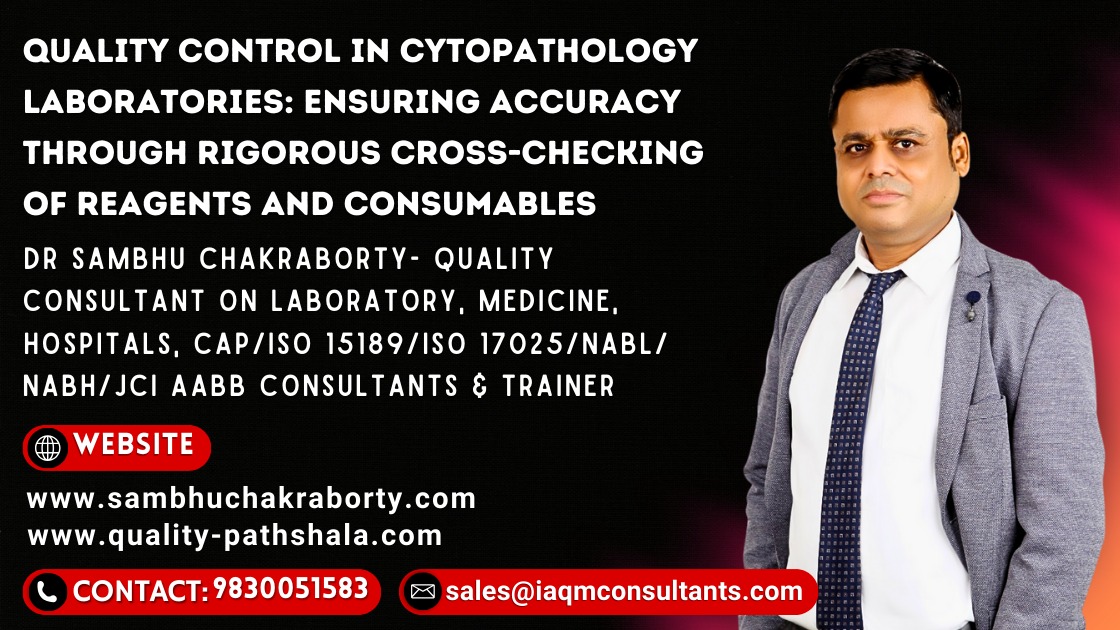Cytopathology, a vital branch of pathology, involves the examination of cells from various body sites to diagnose diseases, including cancer. The accuracy of cytopathological diagnoses hinges on the quality of reagents, chemicals, and consumables used in sample preparation, staining, and analysis. This article outlines a comprehensive procedure for cross-checking these essential materials to meet the stringent requirements for testing, ensuring the reliability of diagnostic outcomes.
Introduction
The precision of cytopathological testing is critical for patient care, as these results often play a pivotal role in diagnosing and determining the treatment pathway for various conditions. Given the high stakes, cytopathology laboratories must implement a robust quality assurance (QA) system focusing on the integrity and performance of reagents, chemicals, and consumables.
Key Reagents and Consumables
Critical materials whose quality must be assured include:
- Fixatives (e.g., formalin, alcohol-based solutions): Preserve cell morphology and prevent degradation.
- Stains (e.g., Papanicolaou (Pap) stain, Hematoxylin and Eosin (H&E)): Essential for visualizing cellular details and abnormalities.
- Cover Slips and Slides: The medium on which samples are mounted for examination.
- Antibodies for Immunocytochemistry: Used to detect specific antigens within cells, providing diagnostic or prognostic information.
- Quality Control (QC) Slides: Prepared slides with known cellular characteristics used to validate staining processes and equipment calibration.
Cross-Checking Procedure
1. Vendor Selection and Evaluation
Choose vendors based on their reputation for supplying high-quality materials and their compliance with relevant standards. Periodically review vendor performance to ensure consistent quality.
2. Receiving and Storage
Inspect shipments upon arrival for damage and ensure that reagents and consumables are stored according to the manufacturer’s specifications. This is crucial for temperature-sensitive items like antibodies, which may lose specificity if improperly stored.
3. Documentation for Traceability
Maintain detailed records of all materials, including lot numbers, expiration dates, and storage conditions. This documentation is essential for traceability in case of any discrepancies in test results.
4. Quality Control Testing
Before deploying new batches of reagents and consumables in diagnostic procedures, conduct rigorous QC tests:
- Fixatives: Verify their effectiveness in preserving cell morphology on control samples.
- Stains: Perform staining on QC slides to ensure the clarity, specificity, and consistency of cellular detail visualization.
- Antibodies for Immunocytochemistry: Test on cells with known antigen expression to confirm specificity and optimal staining conditions.
- Slide and Cover Slip Integrity: Check for cleanliness and absence of defects that could affect sample visualization.
5. Continuous Performance Monitoring
Regularly monitor the performance of reagents, chemicals, and consumables. Any deviation from expected results should prompt a review of the QC process and materials in question.
6. Expiry Date and Inventory Management
Regularly audit inventory to use materials within their effective shelf life and follow a first-in, first-out (FIFO) system to minimize the use of expired materials.
7. Handling and Disposal
Train staff on the correct handling and disposal of cytopathology materials, following safety and environmental regulations to prevent contamination and ensure the safety of laboratory personnel.
8. Continuous Improvement
Leverage insights from the QC process to enhance procurement, storage, and usage protocols. Stay abreast of advances in cytopathology materials and techniques to continually improve diagnostic accuracy.
Conclusion
Implementing a detailed cross-checking procedure for reagents, chemicals, and consumables in cytopathology laboratories is fundamental to maintaining the accuracy and reliability of diagnostic tests. Through diligent quality assurance practices, laboratories can ensure the highest standards of patient care, reinforcing the critical role of cytopathology in the medical diagnostic landscape. This commitment to quality not only supports precise patient diagnoses but also contributes to the advancement of cytopathological science.
About the Author
Dr. Sambhu Chakraborty is a distinguished consultant in quality accreditation for laboratories and hospitals. With a leadership portfolio that includes directorial roles in two laboratory organizations and a consulting firm, as well as chairman of IOL ( An ILAC stakeholder organisation), Dr. Chakraborty is a respected voice in the field. For further engagement or inquiries, Dr. Chakraborty can be contacted through email at director@iaqmconsultants.com and contact information are available on his websites,https://www.quality-pathshala.com and https://www.sambhuchakraborty.com , or via WhatsApp at +919830051583.
